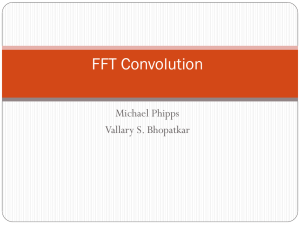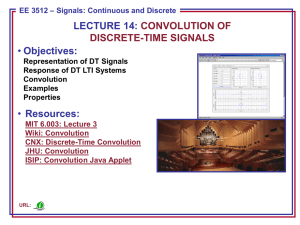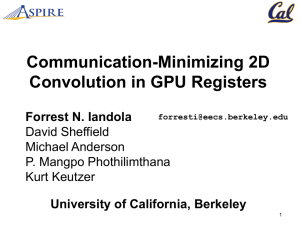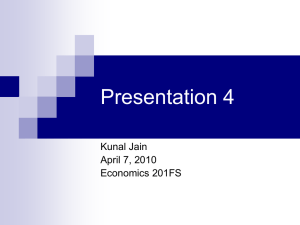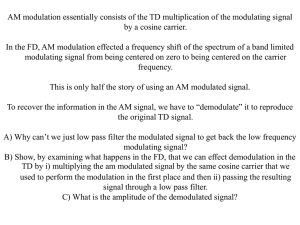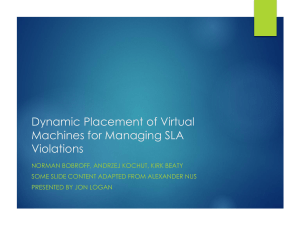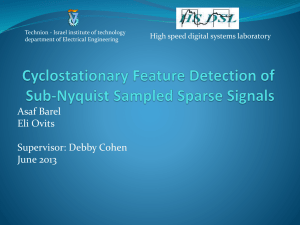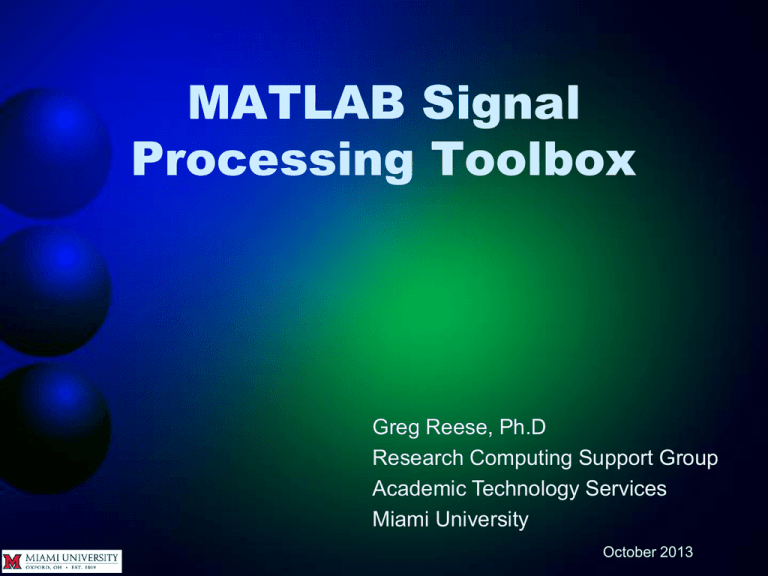
MATLAB Signal
Processing Toolbox
Greg Reese, Ph.D
Research Computing Support Group
Academic Technology Services
Miami University
October 2013
MATLAB Signal
Processing Toolbox
© 2013 Greg Reese. All rights reserved
2
Toolbox
Toolbox
• Collection of code devoted to solving
problems in one field of research
• Can be purchased from MATLAB
• Can be purchased from third parties
• Can be obtained for free from third parties
3
Toolbox
MATLAB Signal Processing Toolbox
• Code for solving problems in signal
processing (!)
• Sold by MATLAB
• Part of both Miami’s student and
faculty license
4
Overview
MATLAB divides Signal Processing
Toolbox as follows
• Waveforms
– Pulses, modulated signals, peak-to-peak and RMS
amplitude, rise time/fall time, overshoot/undershoot
• Convolution and Correlation
– Linear and circular convolution, autocorrelation,
autocovariance, cross-correlation, cross-covariance
• Transforms
– Fourier transform, chirp z-transform, DCT, Hilbert
transform, cepstrum, Walsh-Hadamard transform
5
Overview
• Analog and Digital Filters
– Analog filter design, frequency transformations, FIR and IIR
filters, filter analysis, filter structures
• Spectral Analysis
– Nonparametric and parametric spectral estimation, high
resolution spectral estimation
• Parametric Modeling and Linear
Prediction
– Autoregressive (AR) models, linear predictive coding (LPC),
Levinson-Durbin recursion
• Multirate Signal Processing
– Downsampling, upsampling, resampling, anti-aliasing filter,
interpolation, decimation
6
Overview
Will look very briefly at
• Analog and Digital Filters
• Spectral Analysis
• Parametric Modeling and Linear Prediction
• Multirate Signal Processing
Will look in more depth at
• Waveforms
• Convolution and Correlation
7
Analog and Digital Filters
Toolbox especially good for those serious
about their filter design!
Analog filters
• Standard filters
– Bessel, Butterworth, Chebyshev, Elliptic
• Filter transforms
– Low pass to: bandpass, bandstop, or highpass
– Change cutoff frequency of lowpass
• Analog to digital filter conversion
– Bilinear transformation
8
Analog and Digital Filters
Digital Filter Design with functions
• Standard filters
– Butterworth, Chebyshev, Elliptic
• FIR and IIR design
– Low pass to: bandpass, bandstop, or highpass
– Change cutoff frequency of lowpass
• Objects for specification of filters
– Arbitrary, lowpass, highpass, bandpass, Hilbert
9
Analog and Digital Filters
Digital Filter Design interactively (GUI)
• Filterbuilder – specify desired
characteristics first, then choose filter type
– Butterworth, Chebyshev, Elliptic
• FDATool (Filter Design and Analysis Tool)
– Quickly design digital FIR or IIR filters
– Quickly analyze filters, e.g., magnitude/phase
response, pole-zero plots
10
Analog and Digital Filters
SPTool – composite of four tools
1. Signal Browser – analyze signals
2. FDATool
3. FVTool (Filter Visualization Tool) –
analyze filter characteristics
4. Spectrum Viewer – spectral analysis
11
Analog and Digital Filters
Digital Filter Analysis
• Magnitude and phase response, impulse
response, group delay, pole-zero plot
Digital Filter Implementation
• Filtering, direct form, lattice, biquad, statespace structures
12
Spectral Analysis
Nonparametric Methods
– Periodogram, Welch's overlapped segment
averaging, multitaper, cross-spectrum,
coherence, spectrogram
Parametric Methods
– Yule-Walker, Burg, covariance, modified
covariance
Subspace Methods
– Multiple signal classification (MUSIC),
eigenvectorestimator, pseudospectrum
• Windows
– Hamming, Blackman, Bartlett, Chebyshev,
Taylor, Kaiser
13
Parametric Modeling and
Linear Prediction
Parametric Modeling
• AR, ARMA, frequency response
modeling
Linear Predictive Waveforms
• Linear predictive coefficients (LPC), line
spectral frequencies (LSF), reflection
coefficients (RC), Levinson-Durbin
recursion
14
Multirate Signal Processing
Multirate signal processing
– Downsampling, upsampling, resampling,
anti-aliasing filter, interpolation, decimation
15
Waveforms
Waveforms part of toolbox lets you create
many commonly used signals, which you
can use to study models programmed in
MATLAB
Uses of waveforms
• Testing
– E.g., have simple waveform and can analytically
determine model’s output. Use toolbox to create that
waveform, run it through MATLAB model, confirm
result
16
Waveforms
Uses of waveforms
• Simulation
– Most of time can’t get analytical output
– Make waveform of known characteristics
and study model’s response
• Modeling of real signals
– Create waveform that looks like the real
signal
17
Waveforms
Time vectors
Digital signals usually sampled from
analog at fixed intervals Δt . Want time
axis with N points
0
1Δt
2Δt
…
(N-2)Δt (N-1)Δt
18
Waveforms
For
–
–
–
–
tStart: starting time
tEnd: ending time
N: number of points
deltaT: sampling interval
• If have starting time, number of points,
interval, (tStart, N, deltaT):
>> deltaT = 0.1;
>> N = 10;
>> t0 = 5;
>> t = t0 + deltaT * (0:N-1)
t = 5.0 5.1 5.2 5.3 5.4 5.5
5.6
5.7
5.8
5.9
19
Waveforms
• If have starting time, ending time, interval
(tStart, tEnd, deltaT)
>> tStart = 5;
>> tEnd = 5.9;
>> deltaT = 0.1;
>> t = tStart:deltaT:tEnd
t = 5.0 5.1 5.2 5.3 5.4
5.5
5.6
5.7
5.8
5.9
• If have starting time, ending time, number of
points (tStart, tEnd, N)
>> tStart = 5;
>> tEnd = 5.9;
>> N = 10;
>> t = linspace( tStart, tEnd, N )
t = 5.0 5.1 5.2 5.3 5.4 5.5 5.6
5.7
5.8
5.9
20
Waveforms
In multichannel processing, a number of
signals are gathered at the same time
• Will assume all sampled at same time and
same rate
Signal processing toolbox, and MATLAB
in general, treats each column of a
matrix (2D array) as an independent
column vector
21
Waveforms
Example
>> M = [ 1:3; 4:6; 7:9; 10:12 ]
M = 1
2
3
4
5
6
7
8
9
10
11
12
>> mean( M )
ans =
5.5000
6.5000
7.5000
Result is mean of each column
22
Waveforms
TIP
Make time vector be a column vector
• Any vectors created from time vector
will also be column vectors and so
can be processed more easily
>> t = t
t = 1
2
3
4
5
6
>> y = abs( t - 3 )
y =
2
1
0
1
Column vector begeteth column vector
2
3
23
TIP
Waveforms
repmat (replicate matrix) is general
purpose function to make large matrix by
replicating small one
Trick - quick way to replicate column vector,
i.e., to make an m x n matrix T out of an m x
1 column vector v, is
T = v(:,ones(1,n))
>> v = (1:5)
v =
1
2
3
4
5
>> v(:,ones(1,3))
ans = 1
1
1
2
2
2
3
3
3
4
4
4
5
5
5
24
Waveforms
TIP
Trick - quick way to replicate row vector,
i.e., to make an m x n matrix T out of an 1 x
n row vector v, is
T = v(ones(m,1),:)
>> v = 1:3
v = 1 2 3
2
3
4
5
>>
T = v( ones(6,1), : )
ans = 1
2
3
1
2
3
1
2
3
1
2
3
1
2
3
1
2
3
25
Waveforms
TIP
Can use preceding two tips to make
multichannel signal, e.g.,
Simulate the multichannel signal
sin(2πt), sin(2πt/2), sin(2πt/3),
sin(2πt/4) sampled for one second
at one-tenth second per sample
26
Waveforms
TIP
>> t = (0:0.1:1)'
t =
0
0.1000
0.2000
0.3000
0.4000
0.5000
0.6000
0.7000
0.8000
0.9000
1.0000
27
TIP
Waveforms
>> T = t(:,ones(1,4))
T =
0
0
0.1000
0.1000
0.2000
0.2000
0.3000
0.3000
0.4000
0.4000
0.5000
0.5000
0.6000
0.6000
0.7000
0.7000
0.8000
0.8000
0.9000
0.9000
1.0000
1.0000
0
0.1000
0.2000
0.3000
0.4000
0.5000
0.6000
0.7000
0.8000
0.9000
1.0000
0
0.1000
0.2000
0.3000
0.4000
0.5000
0.6000
0.7000
0.8000
0.9000
1.0000
28
TIP
Waveforms
>> M = T ./ C
M =
0
0
0.1000
0.0500
0.2000
0.1000
0.3000
0.1500
0.4000
0.2000
0.5000
0.2500
0.6000
0.3000
0.7000
0.3500
0.8000
0.4000
0.9000
0.4500
1.0000
0.5000
0
0.0333
0.0667
0.1000
0.1333
0.1667
0.2000
0.2333
0.2667
0.3000
0.3333
0
0.0250
0.0500
0.0750
0.1000
0.1250
0.1500
0.1750
0.2000
0.2250
0.2500
29
TIP
Waveforms
>> signal = sin( 2*pi*M
signal =
0
0
0.5878
0.3090
0.9511
0.5878
0.9511
0.8090
0.5878
0.9511
0.0000
1.0000
-0.5878
0.9511
-0.9511
0.8090
-0.9511
0.5878
-0.5878
0.3090
-0.0000
0.0000
)
0
0.2079
0.4067
0.5878
0.7431
0.8660
0.9511
0.9945
0.9945
0.9511
0.8660
0
0.1564
0.3090
0.4540
0.5878
0.7071
0.8090
0.8910
0.9511
0.9877
1.0000
30
Waveforms
Impulse
• Use to compute impulse response
of linear, time-invariant system
>> t = (0:0.1:1.9)';
>> impulse = zeros( size(t) );
>> impulse( 1 ) = 1;
Impulse
1
0.9
0.8
0.7
0.6
0.5
0.4
0.3
0.2
0.1
0
0
0.2
0.4
0.6
0.8
1
1.2
1.4
1.6
1.8
2
31
Waveforms
Step
• Use to model switch turning on
>> t = (-1:0.1:0.9)';
>> step = [ zeros(10,1); ones(10,1) ];
Step
1
0.9
0.8
0.7
0.6
0.5
0.4
0.3
0.2
0.1
0
-1
-0.8
-0.6
-0.4
-0.2
0
0.2
0.4
0.6
0.8
1
32
Waveforms
Ramp
• Use to model something gradually turning on
>> t = (0:0.1:1.9)';
>> ramp = t;
Ramp
2
1.8
1.6
1.4
1.2
1
0.8
0.6
0.4
0.2
0
0
0.2
0.4
0.6
0.8
1
1.2
1.4
1.6
1.8
2
33
Autocorrelation
Autocorrelation – the detection of a delayed
version of a signal
• In temporal signal, delay often called “lag”
• In spatial signal, delay often called
“translation” or “offset”
• Delayed signal may also be scaled
Can also think of autocorrelation as
similarity of a signal to itself as a function of
lag
34
Autocorrelation
Autocorrelation and cross-correlation
• Common in both signal processing
and statistics
• Definitions and uses are different
• When looking for help on these
topics, make sure you’re looking at
a signal-processing source
35
Autocorrelation
Examples of autocorrelation of digital signals
• Radar – determine distance to object
• Sonar – determine distance to object
• Music
– Determine tempo
– Detect and estimate pitch
• Astronomy – Find rotation frequency of pulsars
36
Autocorrelation
Examples of spatial autocorrelation
• Optical Character Recognition (OCR) – reading
text from images of writing/printing
• X-ray diffraction – helps recover the "Fourier
phase information" on atom positions
• Statistics – helps estimate mean value
uncertainties when sampling a heterogeneous
population
• Astrophysics – used to study and characterize
the spatial distribution of galaxies
37
Autocorrelation
Examples of optical autocorrelation
• Measurement of optical spectra and of very
short-duration light pulses produced by lasers
• Analysis of dynamic light scattering data to
determine particle size distributions
• The small-angle X-ray scattering intensity of
some systems related to the spatial
autocorrelation function of the electron density
• In optics, normalized autocorrelations and
cross-correlations give the degree of
coherence of an electromagnetic field
38
Autocorrelation
Typical use
• Blip sent to object
• Small blip reflected from
object back to sender
• Use autocorrelation to detect
small blip at some lag
• Know velocity of blip in medium so total
distance blip traveled is
distance = velocity * lag
• Distance is round trip, so
object distance/2 away
39
Autocorrelation
Autocorrelation
• Multiply and sum. Result is autocorrelation at
that point
• Slide over one, multiply and sum
10
10
10
10
x
x
x
x
0
0
0
0
0
1
1
1
0
0
10∙0 + 10∙0 + 10∙0 +=10∙0
0
=0
40
Autocorrelation
Autocorrelation
• Repeat, sliding in both directions until have
covered all positions
• What happens when go
past end?
10
10
10
0
0
0
0
0
1
1
1
x
x
x
0
0
?
10∙0 + 10∙0 +
?
41
Autocorrelation
When go past end, have two options
Zero – padding – put zeros on both end of both
signals. Can either imagine they are there or
actually extend arrays in memory and put in
zeros
0
0
0
0
0
0
0
0
1
1
1
10
10
10
x
x
x
0
0
0
0
0
10∙0 + 10∙0 + 10∙0 = 0
Will discuss second option later
42
Autocorrelation
Suppose the real discrete-time signal x[n] has
L points and the real discrete-time signal y[n]
has N points, with L ≤ N. The autocorrelation of
x and y is
𝐿−𝑚−1
𝑅𝑥𝑦 𝑚 =
𝑥 𝑛 + 𝑚 𝑦[𝑛]
𝑛=0
for m = -(N-1), -(N-2), …, -1, 0, 1, 2, …, L-1
43
Autocorrelation
Aside
• For p≥0, x[n-p] is x[n]
shifted to the right by p
• For p≥0, x[n+p] is x[n]
shifted to the left by p
Example
• Unit impulse
1
x[n]
x[n+5]
x[n-2]
0.8
0.6
0.4
0.2
0
-6
-5
-4
-3
-2
-1
0
1
2
3
n
1 for 𝑛 = 0
𝑥𝑛 =
0 for 𝑛 ≠ 0
44
Autocorrelation
TRY IT
At time n=0 a transmitter sends out a
pulse of amplitude ten and duration 3.
At time time n=5 it gets back the
reflected pulse with the same duration
but one tenth the amplitude. What is the
autocorrelation?
45
Autocorrelation
TRY IT
Sent
Received
10
10
10
10
10
10
0
0
0
10
10
0
0
10
10
10
0
0
0
0
1
1
1
0
0
Rxy(0) = ?
0
0
1
1
1
0
0
Rxy(0)=0
1
1
0
0
Rxy(1)=0
1
1
0
0
Rxy(2)=0
Rxy(1) = ?
0
0
0
1
Rxy(2) = ?
10
0
0
0
0
0
0
1
46
Autocorrelation
TRY IT
Rxy(-1)=0
0
10
10
10
0
0
0
0
1
10
10
10
Rxy(-2) = ?
0
0
0
1
1
10
10
10
Rxy(-3) = ?
0
0
1
1
10
10
10
0
1
1
1
10
10
10
1
1
1
Rxy(-2)=0
0
0
Rxy(-3)=10
0
0
0
Rxy(-4)=20
0
0
0
0
Rxy(-1) = ?
Rxy(-5)=30
0
0
0
0
0
1
1
0
1
1
0
0
0
0
0
Rxy(-4) = ?
0
0
Rxy(-5) = ?
0
0
47
Autocorrelation
TRY IT
Rxy(-6)=20
0
0
0
Rxy(-6) = ?
10
10
10
0
1
1
0
0
Rxy(-7) = ?
10
10
10
0
1
0
0
10
10
0
0
0
Rxy(-7)=10
0
0
0
0
1
Rxy(-8)=0
0
0
1
1
Rxy(-8) = ?
0
0
0
1
Rxy(-9)=0
0
0
0
0
0
1
1
1
Rxy(-9) = ?
10
1
0
1
0
10
10
10
48
Autocorrelation
TRY IT
Put it together
>> m = 2:-1:-9;
>> R = [ 0 0 0 0 0 10 20 30 20 10 0 0 ];
>> [~,maxIndex] = max( R )
maxIndex = 8
>> m(maxIndex)
ans = -5 % max when shifted right by 5
0
0
0
0
0
1
1
1
0
1
2
3
4
5
6
7
0
8
0
9
49
Autocorrelation
TRY IT
>> plot( -m, R, ‘o’ )
Note shape is a triangle, not a rectangle,
which is shape of pulse. Autocorrelation
detects signal of given shape – it does not
replicate signal
30
25
Autocorrelation(m)
20
15
10
5
0
-2
0
2
4
Lag m
6
8
10
50
Autocorrelation
MATLAB considers what we’re doing
to be cross-correlation
• Concept is same as what described
here for autocorrelation
• If one array shorter than another,
MATLAB pads shorter one with zeros
until both same length
51
Autocorrelation
To compute cross-correlation of
vectors x and y in MATLAB, use
c = xcorr( x, y )
where
• c is a vector with 2N-1 elements
• N is length of longer of x and y
If m is lag as previously defined, c(k)
is autocorrelation for lag m = k - N
52
Autocorrelation
TRY IT
Let’s do previous graphical
autocorrelation with MATLAB
10
10
10
0
0
0
0
0
1
1
1
0
0
>> x = [ 10 10 10 ];
>> y = [ 0 0 0 0 0 1 1 1 0 0 ];
>> c = xcorr( x, y );
>> [~,maxCix] = max( c )
maxCix = 5
>> m = maxCix - length( y )
m = -5 % Move 5 to right from element 1
53
Autocorrelation
TRY IT
Example of finding signal buried in noise
1. Make a sine wave with a period of 20 and
amplitude of 100
>>
wave = 100 * sin( 2*pi*(0:19)/20 );
2. Reset random number generator
(so we all get the same random numbers)
>> rng default
3. Make 500 points of noise with randn and
variance 75% of wave amplitude
noisyWave = 75 * randn( 1, 500 );
54
Autocorrelation
TRY IT
4. Pick a random spot to place the wave,
ensuring that the whole wave fits in
ix = randi( [ 1, 481 ] );
5. Add the wave to the noise
noisyWave(ix:ix+19)=noisyWave(ix:ix+19)+wave;
Plot wave in noise. Is wave visible?
plot( noisyWave )
300
200
100
0
-100
-200
6. Compute autocorrelation
-300
0
50
100
>> c = xcorr( wave, noisyWave );
150
200
250
300
350
400
450
500
55
Autocorrelation
TRY IT
7. Find max of autocorrelation and
calculate lag from that
>> [~,maxIx] = max( c )
maxIx = 269
>> m = maxIx – 500
m = -231 % shift 231 to right
8. Show random spot where wave added
to noise. Match?
>> ix
ix = 231
Very close match! m should be -230
56
Autocorrelation
TRY IT
9. For grins, plot autocorrelation
>> lags = -499:499;
>> plot( lags, c )
Why is almost
all of right
size zero?
• Right side
corresponds to
shifting left and once
shift wave more than
20, rest of wave
is zeros
4
8
x 10
6
4
2
0
-2
-4
-6
-8
-500
-400
-300
-200
-100
0
100
200
300
400
500
57
Correlation
Questions?
58
Convolution
convolution
• Uses
– Polynomial multiplication
– LTI response
– Joint PDF
• Linear and circular
– Explain, show when equivalent (padding), good for
computing convolution with fft. Do example with
tic,toc, time-domain convolution vs. fft,ifft, see cconv
59
Convolution
Applications of convolution
• Acoustics – reverberation is the convolution of
the original sound with echoes from objects
surrounding the sound source
• Computational fluid dynamics – the large eddy
simulation (LES) turbulence model uses
convolution to lower the range of length scales
necessary in computation and thereby reducing
computational cost
• Probability – probability distribution of the sum
of two independent random variables is the
convolution of their individual distributions
60
Convolution
Applications of convolution
• Spectroscopy – line broadening can be due to
the Doppler effect and/or collision broadening.
The effect due to both is the convolution of the
two effects
• Electronic music – imposition of a rhythmic
structure on a sound done by convolution
• Image processing – blurring, sharpening, and
edge enhancement done by convolution
• Numerical computation – can multiply
polynomials quickly with convolution
61
Convolution
Convolution finds many applications
because it is central to linear, timeinvariant systems and many things
can be modeled by such systems
62
Convolution
Linear – a linear system obeys two principles
– Principle of superposition – the output to a sum of
inputs is equal to the sum of the outputs to the
individual inputs
– Scaling – the output to the product of an input and a
constant is the product of the constant and the output
to the input alone
– In other words, for a linear system L,
a L{ x(t) } + bL{ x(t) } = L{ ax(t) + bx(t) }
63
Convolution
Suppose you put some input into a
system and get some output. If you put
in the same input at a later time, if the
system is time invariant, the output will
be the same as the original output
except it will occur at that later time
– In other words, for a time-invariant system S,
If y(t) = S{ x(t) }, then y(t-t0) = S{ x(t-t0) }
Time-invariance and linearity are independent. A
linear system can be time-invariant or not. A timeinvariant system can be linear or not.
64
Convolution
Example
Change machine at a laundromat.
Put in dollar bills, press button, get out
quarters
Linear?
1. Put $1 in, press button, get 4 quarters out
2. Put $2 in, press button, get 8 quarters out
3. (output from $1) + (output from $2) = 12
quarters
4. Put $3, press button, get 12 quarters out
5. Two outputs equal, so system linear
65
Convolution
Example
Time invariant?
1. Put $1 in, press button, get 4 quarters out
2. Put $2 in, press button, get 8 quarters out
An hour later
1. Put $1 in, press button, get 4 quarters out
2. Put $2 in, press button, get 8 quarters out
Outputs identical except for same delay as
input, so system is time invariant
66
Convolution
1 for 𝑛 = 0
(discrete) impulse: δ 𝑛 =
0 for 𝑛 > 0
impulse response –response h[n] of a
system S when the input is an impulse,
i.e.,
h[n] = S { δ 𝑛 }
67
Convolution
Major fact
The output of a linear, time-invariant
(LTI) system to any input is the
convolution of that input with the
system’s impulse response
Other words:
• The impulse response of an LTI system
completely characterizes that system
• The impulse response of an LTI system
specifies that system
68
Convolution
Graphical view of convolving two signals
• Pick one signal 3 2 1
• Flip it 180° around left edge
3
2
1
1
2
3
• Position right element of flipped signal
over left element of unflipped signal
1
2
3
1
0
2
2
5
-2
-2
0
0
1
69
Convolution
Graphical view
• Multiply corresponding elements and sum
1
2
3
x
1
0
2
2
5
-2
-2
0
0
1
3∙1
3
70
Convolution
Graphical view
• Slide right, multiply, sum
1
2
3
x
x
1
0
2
2
5
-2
-2
0
0
1
2∙1 + 3∙0
3
2
71
Convolution
Graphical view
• Repeat until “fall off” right side
1
2
3
x
x
x
1
0
2
2
5
-2
-2
0
0
1
1∙1 + 2∙0 + 3∙2
3
2
7
72
Convolution
Graphical view
1
1
2
3
x
x
x
0
2
2
5
-2
-2
0
0
1
1∙0 + 2∙2 + 3∙2
3
2
7
10
73
Convolution
Graphical view
1
0
1
2
3
x
x
x
2
2
5
-2
-2
0
0
1
1∙2 + 2∙2 + 3∙5
3
2
7
10
21
74
Convolution
Graphical view
1
0
2
1
2
3
x
x
x
2
5
-2
-2
0
0
1
1∙2 + 2∙5 + 3∙(-2)
3
2
7
10
21
6
75
Convolution
Graphical view
1
0
2
2
1
2
3
x
x
x
5
-2
-2
0
0
1
1∙5 + 2∙(-2) + 3∙(-2)
3
2
7
10
21
6
-5
76
Convolution
Graphical view
1
0
2
2
5
1
2
3
x
x
x
-2
-2
0
0
1
1∙(-2) + 2∙(-2) + 3∙0
3
2
7
10
21
6
-5
-6
77
Convolution
Graphical view
1
0
2
2
5
-2
1
2
3
x
x
x
-2
0
0
1
1∙(-2) + 2∙0 + 3∙0
3
2
7
10
21
6
-5
-6
-2
78
Convolution
Graphical view
1
0
2
2
5
-2
-2
1
2
3
x
x
x
0
0
1
1∙0 + 2∙0 + 3∙1
3
2
7
10
21
6
-5
-6
-2
3
79
Convolution
Graphical view
• As with correlation, ignore elements that have
fallen off or pad bottom array with zeros
1
0
2
2
5
-2
-2
0
1
2
x
x
0
1
3
1∙0 + 2∙1
3
2
7
10
21
6
-5
-6
-2
3
2
80
Convolution
Graphical view
1
2
3
2
1
x
1
0
2
2
5
-2
-2
0
0
1
1∙1
3
2
7
10
21
6
-5
-6
-2
3
81
Convolution
So convolution of
3
2
1
with
1
0
2
2
5
-2
-2
0
0
1
gives
3
2
7
10
21
6
-5
-6
-2
3
2
1
82
Convolution
Note that when we convolved
with
1
0
2
2
5
-2
-2
0
0
1 the shorter
signal was not completely on top of the longer
one for the first two and last two elements of the
longer. For these cases, the multiply-and-add
convolution computation was missing either one
or two terms, so those four calculations are not
valid and should be ignored. Bad values at the
left and right of a convolution are known as edge
effects.
3
2
1
83
Convolution
In general, if the shorter of two signals
in a convolution has M elements, you
should ignore the first and last M-1
elements in the result
84
Convolution
Mathematical definition
Suppose we have two signals – x[n] has M
points and y[n] has N points, M ≤ N. The
convolution of x[n] and y[n] is
𝑛
𝑥 𝑛−𝑘 𝑦 𝑘
for 𝑛 = 0,1,2, … 𝑀 − 1
𝑘=0
𝑛
𝑤 𝑛 =
𝑥 𝑛 − 𝑘 𝑦[𝑘]
for 𝑛 = 𝑀, 𝑀 + 1, … 𝑁 − 1
𝑘=𝑛−𝑀+1
𝑛
𝑥 𝑛−𝑘 𝑦 𝑘
for 𝑛 = 𝑁, 𝑁 + 1, … 𝑁 + 𝑀 − 2
𝑘=𝑛−𝑀+1
n = 0, 1, 2, … N+M-2
85
Convolution
Compute a convolution in MATLAB with
w = conv( u, v )
where
u and v are vectors. The output vector w
has length length(u)+length(v)-1
86
Convolution
TRY IT
We figured out graphically that
convolved with 1 0 2 2 5
gave 3 2 7 10 21 6 -5 -6
3
2
1
-2
-2
0
0
-2
3
2
1
3
2
1
1
Try it in MATLAB
>> u =
>> v =
>> w =
w = 3
[ 3 2
[ 1 0
conv(
2 7
1 ];
2 2 5 -2 -2 0 0 1 ];
u, v )
10 21 6 -5 -6 -2
87
Convolution
Typically convolution involves a data
signal and another signal. The second
signal, called a kernel, is
• Also called a filter
• Usually much shorter than the data signal
• Designed to produce a desired effect on
the data
88
Convolution
TRY IT
To introduce a time lag of m units
into the data signal, i.e., to shift it
to the right by m, use a kernel of m
zeros followed by a one.
Example
Introduce
1
0
2 a lag
2 of
5 two
-2 into
-2 the
0 signal
0
1
>> kernel = [ 0 0 1 ];
>> w = conv( kernel, v )
w = 0 0 1 0 2 2 5 -2 -2 0 0 1
89
Convolution
TRY IT
Approximate the derivative by
replacing a point with the difference
between itself and the previous point
Example
Approximate the derivative of
1
0
2
2
5
-2
>> u = [ 1 -1 ];
>> w = conv( u, v )
w = 1 -1 2 0 3 -7
-2
0
0
0
2
1
0
1 -1
90
Convolution
TRY IT
Reduce noise in a signal by replacing
a point with a weighted average of
itself and the previous two points
Example
1
0
2
2
5
-2
-2
0
0
1
>> kernel = (1/9)*[ 5 3 1 ];
>> w = conv( u, v );
w*9 = 5 3 11 16 33 7 -11 -8 -2 5 3 1
91
Convolution
Questions?
92
Signal Processing
Toolbox
Questions?
93
The End
94

